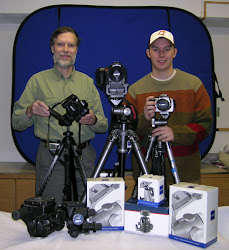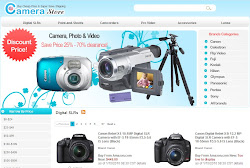If you want an affordable Konica Minolta digital camera with a full set of features - and which actually feels like an SLR - the DiMAGE Z6 will live up to your expectations!
The Konica Minolta Digital Camera DiMage Z6 retains most of the good features and specifications of its predecessor, the Z5, and increases the available megapixels to 6.
However, there is one drawback in the Konica Minolta Digital Camera DiMage Z6 to be mentioned right from the start: While comparable prosumer cameras are upgrading their movie feature set, it is considered somewhat incomprehensible that Minolta has decided to downgrade the movie standard to 320 x 240 (15/30 fps)! On the plus side, the camera features a night capture movie mode.
Be that as it may (it is primarily a still camera and not a video camera!), the Konica Minolta Digital Camera DiMage Z6 continues to use the popular 12X zoom lens with the Anti-Shake image stabilization, which seems to work very effectively. This is the same image stabilization system as that used in the top-of-the-line Maxxum 7D digital SLR. There are some reports though of softer images with the zoom fully extended.
The Konica Minolta Digital Camera DiMAGE has a focal range of 35mm to 420mm (35mm equivalent), which provides an excellent telephoto reach. Unfortunately there is no Auto Focus illuminator available.
You also won't be disappointed by its close-up possibilities. In Macro or Super Macro mode you can get the lens of the Konica Minolta Digital Camera DiMAGE Z6 as close as 1cm from the subject.
And while on the subject of modes, this Minolta offers a number of pre-set program modes which will help many a photographer out in a tricky moment: Portrait, Sports Action, Landscape, Sunset, Night Portrait, and more.
The Konica Minolta Digital Camera DiMAGE Z6 uses four widely available AA Alkaline batteries that keeps the camera running for up to approximately 240 shots. It can also use high-capacity rechargeable Ni-MH batteries for up to approximately 420 shots.
Although this particular Konica Minolta digital camera needs about 3 seconds to extend its zoom lens, it is quite fast when it comes to continuous shooting, and at high resolution, you might get up to 16 images at a rate of 1.8fps. This is better than some in its class.
The Konica Minolta Digital Camera DiMAGE Z6 uses the JPEG file format. It features Secure Digital memory, and a 16 MB SD card is supplied. Another big plus for this camera is that an external flash hot-shoe is available.
While some photographers might take issue with aspects of its image quality. the DiMAGE Z6 has enough in its feature-set to keep many enthusiasts happy. In fact, with its somewhat daring and definitely innovative styling, it is hard not to notice this Konica Minolta digital camera!
For more information visit Best-Digital-Photography.com
Links : Buy Furniture Stores buy tools sale Cheap Clothing Optional Galleries Store








